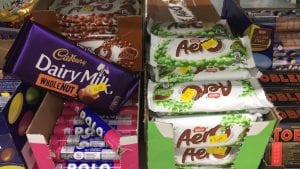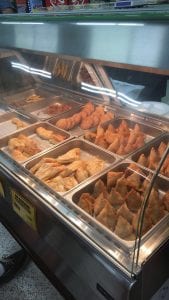To the disbelief of some of my classmates, our trip to the Indian Bazaar was a milestone for me because it was my first time having Indian food. Ever. I walked through the door eager to try new things, and was pleasantly overwhelmed by everything going on around me. My first encounter with the grocery store consisted of the heavy scent of spices, a long shelf filled with nothing but rice, and a woman behind a counter asking if I was ready to order (I wasn’t). I was taken aback by the environment I found myself in, but after glancing around I realized it was very similar to Vik’s, the chaat house in California.
The Bazaar, like Vik’s, consisted of a checkout counter and menu near the door, along with a dining area to the side. Adjacent to this was the grocery store, with shelves upon shelves of food I had never seen before. I saw firsthand the “unique interdependent yet independent nature of the chaat café”, in that the café, although connected to the grocery store, seemed to exist in its own sphere within the bigger context of the bazaar (Sen 216). We were given a sense of the polyryhythmia mentioned by Sen, in that it was easy to go from shopping to eating, seeing as the two were not technically separated, but sitting in the dining area had a different feel than walking down the aisles. The mixing of environments was fascinating, and made for a very interesting eating experience.
After having Dr. Ball-Phillips explain the entire menu to us, I tried the Aloo Tikki Chaat, a Mango Lassi, and bravely at some Pani Puri. I loved it all. Despite being initially terrified when told the Pani Puri was both spicy and had to be eaten all at once, I enjoyed the vibrant flavor and the relatively manageable spice level. The Mango Lassi was essentially a super creamy smoothie, and the Aloo Tikki Chaat was a delicious jumble of ingredients that I could not easily identify, but enjoyed all the same. Both surprised and proud at having liked everything I tried, I decided to venture into the actual grocery store.

Aero bars and Cadbury chocolate, some of the British candy available in the grocery store
I expected to be surrounded by food that I wasn’t familiar with, and I was, but what I didn’t expect to find were snacks I recognized. The unknown mixed with the known, such as the ice-cream, which came in the exotic flavors of “Kaju Draksh”, “Pista Kulfi”, and “Tutti Frutti”. Everywhere I looked I saw that the Bazaar, like Vik’s, “displayed racial, occupational, ethnic, and age diversity” and “sustained a symbolic economy of cultural difference oriented towards westerners” (Sen 210). This melting pot of diversity was most obvious in the presence of British snacks and commodities, something that I wasn’t prepared for. I shouldn’t have been surprised, since India used to be under British Imperial rule, but I hadn’t counted on British cuisine still having such a prominent place in modern-day Indian shopping centers. From biscuits to candy bars to tea, every now and then I would spot distinctly English snacks that had found their way onto the shelves of the Bazaar. This was what I loved most about the grocery store, because it demonstrated how influences of the past can still be seen in today’s markets.
Overall I couldn’t have been happier with my first experience with Indian food. It was great to eat somewhere out of my comfort zone, and I want to explore more of this style of food in the future.
-Barrett
Works Cited
Sen, Arijit. “From Curry Mahals to Chaat Cafes: Spatialities of the South Asian Culinary Landscape.” California Studies in Food and Culture, Volume 34: Curried Cultures: Globalization, Food, and South Asia. Ed. Krishnendu Ray and Tulasi Srinivas. Berkeley: U of California, 2012. 196-218. Print.



